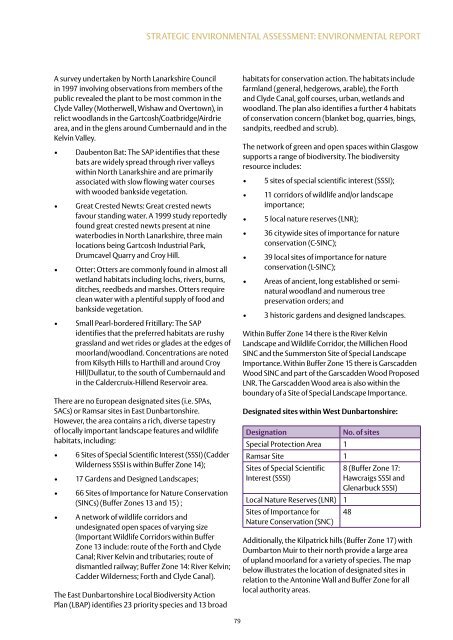The Antonine Wall Management Plan 2013-18 - Glasgow City Council
The Antonine Wall Management Plan 2013-18 - Glasgow City Council
The Antonine Wall Management Plan 2013-18 - Glasgow City Council
Create successful ePaper yourself
Turn your PDF publications into a flip-book with our unique Google optimized e-Paper software.
Strategic Environmental Assessment: Environmental Report<br />
A survey undertaken by North Lanarkshire <strong>Council</strong><br />
in 1997 involving observations from members of the<br />
public revealed the plant to be most common in the<br />
Clyde Valley (Motherwell, Wishaw and Overtown), in<br />
relict woodlands in the Gartcosh/Coatbridge/Airdrie<br />
area, and in the glens around Cumbernauld and in the<br />
Kelvin Valley.<br />
• Daubenton Bat: <strong>The</strong> SAP identifies that these<br />
bats are widely spread through river valleys<br />
within North Lanarkshire and are primarily<br />
associated with slow flowing water courses<br />
with wooded bankside vegetation.<br />
• Great Crested Newts: Great crested newts<br />
favour standing water. A 1999 study reportedly<br />
found great crested newts present at nine<br />
waterbodies in North Lanarkshire, three main<br />
locations being Gartcosh Industrial Park,<br />
Drumcavel Quarry and Croy Hill.<br />
• Otter: Otters are commonly found in almost all<br />
wetland habitats including lochs, rivers, burns,<br />
ditches, reedbeds and marshes. Otters require<br />
clean water with a plentiful supply of food and<br />
bankside vegetation.<br />
• Small Pearl-bordered Fritillary: <strong>The</strong> SAP<br />
identifies that the preferred habitats are rushy<br />
grassland and wet rides or glades at the edges of<br />
moorland/woodland. Concentrations are noted<br />
from Kilsyth Hills to Harthill and around Croy<br />
Hill/Dullatur, to the south of Cumbernauld and<br />
in the Caldercruix-Hillend Reservoir area.<br />
<strong>The</strong>re are no European designated sites (i.e. SPAs,<br />
SACs) or Ramsar sites in East Dunbartonshire.<br />
However, the area contains a rich, diverse tapestry<br />
of locally important landscape features and wildlife<br />
habitats, including:<br />
• 6 Sites of Special Scientific Interest (SSSI) (Cadder<br />
Wilderness SSSI is within Buffer Zone 14);<br />
• 17 Gardens and Designed Landscapes;<br />
• 66 Sites of Importance for Nature Conservation<br />
(SINCs) (Buffer Zones 13 and 15) ;<br />
• A network of wildlife corridors and<br />
undesignated open spaces of varying size<br />
(Important Wildlife Corridors within Buffer<br />
Zone 13 include: route of the Forth and Clyde<br />
Canal; River Kelvin and tributaries; route of<br />
dismantled railway; Buffer Zone 14: River Kelvin;<br />
Cadder Wilderness; Forth and Clyde Canal).<br />
<strong>The</strong> East Dunbartonshire Local Biodiversity Action<br />
<strong>Plan</strong> (LBAP) identifies 23 priority species and 13 broad<br />
habitats for conservation action. <strong>The</strong> habitats include<br />
farmland (general, hedgerows, arable), the Forth<br />
and Clyde Canal, golf courses, urban, wetlands and<br />
woodland. <strong>The</strong> plan also identifies a further 4 habitats<br />
of conservation concern (blanket bog, quarries, bings,<br />
sandpits, reedbed and scrub).<br />
<strong>The</strong> network of green and open spaces within <strong>Glasgow</strong><br />
supports a range of biodiversity. <strong>The</strong> biodiversity<br />
resource includes:<br />
• 5 sites of special scientific interest (SSSI);<br />
• 11 corridors of wildlife and/or landscape<br />
importance;<br />
• 5 local nature reserves (LNR);<br />
• 36 citywide sites of importance for nature<br />
conservation (C-SINC);<br />
• 39 local sites of importance for nature<br />
conservation (L-SINC);<br />
• Areas of ancient, long established or seminatural<br />
woodland and numerous tree<br />
preservation orders; and<br />
• 3 historic gardens and designed landscapes.<br />
Within Buffer Zone 14 there is the River Kelvin<br />
Landscape and Wildlife Corridor, the Millichen Flood<br />
SINC and the Summerston Site of Special Landscape<br />
Importance. Within Buffer Zone 15 there is Garscadden<br />
Wood SINC and part of the Garscadden Wood Proposed<br />
LNR. <strong>The</strong> Garscadden Wood area is also within the<br />
boundary of a Site of Special Landscape Importance.<br />
Designated sites within West Dunbartonshire:<br />
Designation<br />
No. of sites<br />
Special Protection Area 1<br />
Ramsar Site 1<br />
Sites of Special Scientific<br />
Interest (SSSI)<br />
Local Nature Reserves (LNR) 1<br />
Sites of Importance for 48<br />
Nature Conservation (SNC)<br />
8 (Buffer Zone 17:<br />
Hawcraigs SSSI and<br />
Glenarbuck SSSI)<br />
Additionally, the Kilpatrick hills (Buffer Zone 17) with<br />
Dumbarton Muir to their north provide a large area<br />
of upland moorland for a variety of species. <strong>The</strong> map<br />
below illustrates the location of designated sites in<br />
relation to the <strong>Antonine</strong> <strong>Wall</strong> and Buffer Zone for all<br />
local authority areas.<br />
79












![Elgin Cathedral Wedding Brochure [pdf, 544kb] - Historic Scotland](https://img.yumpu.com/22301571/1/190x151/elgin-cathedral-wedding-brochure-pdf-544kb-historic-scotland.jpg?quality=85)



